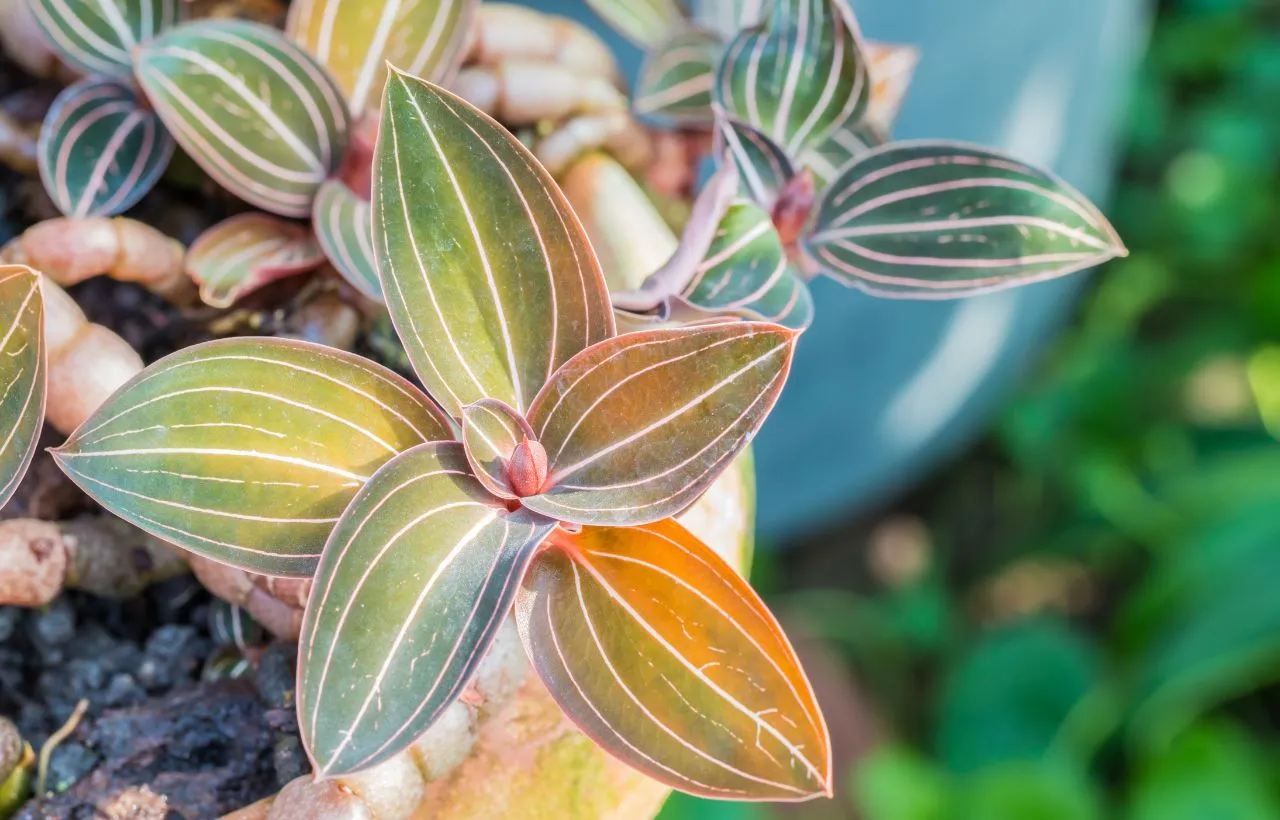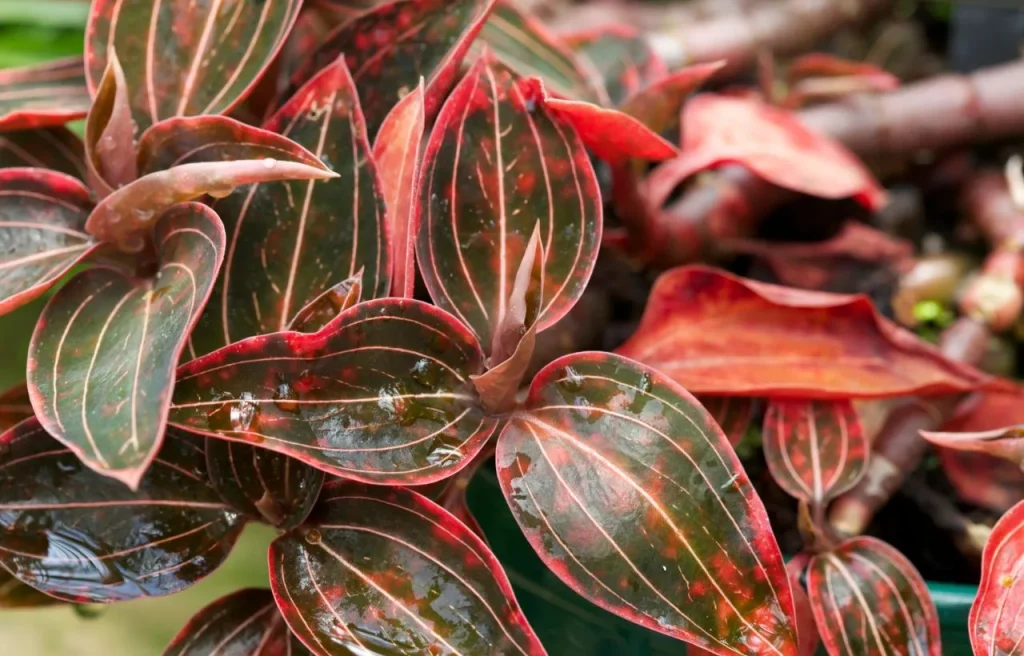Hello garden folks!
I hope your gardens got a great bloom and you are preparing for the upcoming spring. Many wonderful spring flowers bloom in the spring and make you happy. Perennial plants can give you company throughout the year. Let’s count the jewel orchid.
Yes, Jewel orchids, the beautiful herbaceous plants, can give a new look to your indoor pots or garden bed. These plants not only showcase the beautiful leaves. They can even produce fragrant flowers. Are you interested in growing them? Common, let’s dig in the soil and plant Jewel orchid. And welcome to gardening scores to make your garden score 100 out of 100!
Jewel Orchid as a Home plant
Beginning of the Jewel Orchids
In early 1825, the first jewel orchid came into the limelight, and after this, people fell in love with this terrestrial plant. However, the scientific name of the jewel orchid is Ludisia was the first in a row. Since then, it has showcased a lot of species. The name Ludisia represents a lot about the plant. Ludisia means the two colours/discolour of the plants. Though jewel orchids belong to the Orchidaceae family, it doesn’t show up as beautiful flowers. Moreover, the plant enchants people with stipped leaves and leaves with different forms.
The origin of these orchids is from Southeast Asian countries and the pacific. It is native to India, Indonesia, Myanmar, and North America. These plants grow on the forest floor, are wild plants with beautiful foliage, and sometimes come up with white flowers.
These orchids are not famous for flowers. But in Indonesia, they have great importance. People of Indonesia think of it as a symbol of beauty and luck wish.
Varieties
The jewel orchid is a popular home plant. You can build an orchid blossom in your garden effortlessly. There are many species of jewel orchids, like- Alba silver line, Ludisia dis. Alba, Ludisia variegated, Macodes petola, Macodos sanderiana, Aneoctochilus, and many more.
You can plant more than 61 varieties of these dark green orchids in your garden. And guess what? All the varieties are different in shape and colour. Orchid varieties are lucrative always. Some species love the warm weather, and some thrive in cold conditions. So, first, you will enlist your weather condition and USDA zone to plant the varieties. You can easily grow the orchid plants in the USDA zone 6-9. That means in New York, Texas, Alabama, North Carolina and Florida can support the Jewel Orchids. Let’s see more briefly about the varieties:
| Varieties of Jewel Orchid | Physical Appearance | Availability in different countries |
| Ludisia | Got red stripes in the dark green leaves and the most common type of orchid. There are black velvet Ludisia and pale Ludisia. | Malaysia, Cambodia, Vietnam |
| Dossinia | Not available everywhere. Got pretty leaves with yellow, pink and gold stripes. | It is native to Borneo. |
| Anoectochillus | A fancy orchid with different colour stripes. Sometimes red, pink and silver. Guess what? For this multicolour appearance- we call it a marble jewel orchid. | Mostly common in the South Asian countries, Hawaii and Australia. |
Remember all these varieties have several species under them. These houseplants require different soil characteristics and weather.

Growing the Jewel Orchids
The jewel orchids are low-light plants and non-epiphytic. If you are planning to grow them in-house/ garden, you must go through the following:
Soil
These orchids are for you if you can’t maintain the real orchids. Because these are similar to any other indoor plants, so no worries. In the case of propagation, the Ludisia discolour is the thriving one. As a beginner with jewel orchids, you should first try the Ludisia orchid.
Now, the potting mix is similar to all other house plants. You don’t need different types of soil to grow them. Remember, these orchids grow well in the “aerated” soil. 50% peat moss or 50 % sponge rock combined with your regular garden soil can work well. On second thought, if your environment is more humid, you can pick 30% peat/sponge and 70% soil. The orchids love slightly acidic soil.
Noteworthy, don’t try to grow your jewels in clay soil. They don’t like wet feet to grow on. Soil with more air pockets is just what they need.
Temperature
Let’s move on to the temperature requirements that confirm your jewel’s growth triumph. Fortunately, they are tolerant species. At room temperature, they can grow well. 15-28°C is an optimum temperature for them. They are okay with cold and house-temperature but not with high temperatures.
Humidity
Yes, like all other indoor plants, jewels love the humidity. But it’s a robust plant. So, in summer, the humidity is less, or in winter, when humidity is high, your orchid will remain the same. Depending on your zone, if you can give more humidity to the plants, they will be happy. But will humidity, they can still grow.
Light
Shade-loving orchids. They don’t love high-intensity light. They can sit in the corner of your room and grow much well. Low- intermediate shade is right for them. High light can cause that foliage to discolour/ break down. You can even plant them in the bathroom. The fluorescent light is also enough for them. The rule of thumb is to grow them in a shady space because, on the forest floor, they are understory vegetation covered by large canopies. So, low light causes more growth in the jewel orchids.
Fertilizer
They love food and are heavy feeder plants. Slow-release fertilizer works well for them rather than water-soluble fertilizer. If you have mixed the fertilizer with the potting mix before, it’s okay; orchids will love it from the beginning. But even after planting the orchids, you can apply fertilizer. So, it is an easy equation. Patches or yellow leaves can indicate a lack of fertilizer.
Watering Schedule
The plants do not like to dry out entirely/ grow in completely dry topsoil. They love well-drained and airy soil. So, regularly water your plants and check if the topsoil of a minimum of 2 cm has a wet vibe. Otherwise, the foliage will dry out, the stems will break down, and you do not want this to happen, right?
So, these are the minimum and basic requirements for indoor jewel orchids. If you maintain them, you will surely not regret them.
Jewel orchid propagation
Well, the stems of these orchids are sometimes long/ short. If you see a jewel orchid nearby or your friend has it, can you grow the orchids by propagation? Why not? It is an easy method. Stems are succulent and fleshy. First, you will cut the stem from a jewel orchid plant with a tiny, sharp scissor. Of course, sanitize it first. Then you can go for the following two methods-
Water propagation
It is a popular one. And you need to cut down a stem from the mother plant. Then take a jar full of water and dip the cut stem into the water. After 3-4 weeks, you will see the new roots. So, you can plant them.
Direct propagation
After cutting the stem, dip it in hot wax and then pot it in the soil mixture.
Otherwise, if you directly put the cut stem into the soil mix, it will face root pathogens and diseases. So, wrap the cut stem root with hot wax. And then plant it in the soil.
Facts about Orchids
- The flower blossom is r for a couple of weeks, like four weeks. And pluck out the flowers when they dry.
- Jewel orchids are lean plants and have shallow roots. The home gardeners like to plant them on a small patio or pot, but they should have a big mouth. The height of the orchids can be up to 30 cm.
- The flower blooms in early spring/winter (December-March). And flowers have a misty smell not very strong.
- Sometimes, orchids prefer bark chips in soil rather than perlite because perlite can move away from the soil due to watering.
- Most common diseases are leaf blight, root rotting, and leaves curling. Sail attack is very common in the orchids. To treat this you need 3 % of hydrogen peroxide.
- When you see any fungal attack or pests in the jewel orchid, immediately treat the plant with insecticides/ pesticides and apply these until you get back your fresh orchids.
FAQ
So, now that you know a lot about the jewel orchids, still, have some blinks in your head? Then see the following questions:
Are jewel orchids rare?
There are a lot of varieties in this terrestrial orchid. Ludisia is the common one, and other species are easy to get. But some hybrids are still under the wrap.
Can I grow them in water?
No. These orchids are terrestrial and love to propagate in soil. If you think that, unlike other houseplants like coin plants/ money plants, they can stay in the water your jewels will die off.
Why is the jewel orchid turning red?
Orchids are sensitive plants. But this type can grow with less care. Similarly, it requires partial shade means less light. So, if you see your dark green, velvet-like foliage turning red, foliage is suffering from excessive light exposure. Move them immediately to the shade.
Last Word
The beautiful foliage orchids can never offend you. Don’t mind if you can’t grow the real orchids at home with extensive care. These terrestrial orchids can make your indoor gardening easy and beautiful.
So, people from USDA zone 6-9, hurry up. Buy your colourful ports and plant the jewels in them. Jewel orchids will add value to your interior with a greenery touch and sometimes even prettier with white flowers.
Now that you know how to grow and care for the jewel orchids, what are you waiting for? Grow your green interiors now.

